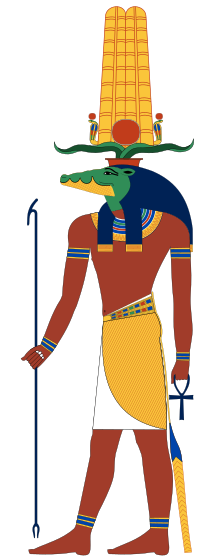Sobek
| Sobek | |||||||
|---|---|---|---|---|---|---|---|
| God of the Nile, the Army, military, fertility and of crocodiles | |||||||
 |
|||||||
| Name in hieroglyphs |
or
|
||||||
| Major cult center | Crocodilopolis, Faiyum, Kom Ombo | ||||||
| Symbol | crocodile | ||||||
| Consort | Renenutet or Meskhenet | ||||||
| Parents | Set/Khnum and Neith | ||||||
| Siblings | Apep, Ra, Thoth, Serket, Hathor | ||||||
Sobek (also called Sebek, Sochet, Sobk, and Sobki), in Greek, Suchos (Σοῦχος) and from Latin Suchus, was an ancient Egyptian deity with a complex and fluid nature. He is associated with the Nile crocodile and is either represented in its form or as a human with a crocodile head. Sobek was also associated with pharaonic power, fertility, and military prowess, but served additionally as a protective deity with apotropaic qualities, invoked particularly for protection against the dangers presented by the Nile river.
Sobek enjoyed a longstanding presence in the ancient Egyptian pantheon, from the Old Kingdom (c. 2686–2181 BCE) through the Roman period (c. 30 BCE – 350 CE). He is first known from several different Pyramid Texts of the Old Kingdom, particularly from spell PT 317. The spell, which praises the pharaoh as living incarnation of the crocodile god, reads:
"Unis is Sobek, green of plumage, with alert face and raised fore, the splashing one who came from the thigh and tail of the great goddess in the sunlight ... Unis has appeared as Sobek, Neith's son. Unis will eat with his mouth, Unis will urinate and Unis will copulate with his penis. Unis is lord of semen, who takes women from their husbands to the place Unis likes according to his heart's fancy."
The origin of his name, Sbk in ancient Egyptian, is debated among scholars, but many believe that it is derived from a causative of the verb "to impregnate".
Though Sobek was worshipped in the Old Kingdom, he truly gained prominence in the Middle Kingdom (c. 2055–1650 BCE), most notably under the Twelfth Dynasty king, Amenemhat III. Amenemhat III had taken a particular interest in the Faiyum region of Egypt, a region heavily associated with Sobek. Amenemhat and many of his dynastic contemporaries engaged in building projects to promote Sobek – projects that were often executed in the Faiyum. In this period, Sobek also underwent an important change: he was often fused with the falcon-headed god of divine kingship, Horus. This brought Sobek even closer with the kings of Egypt, thereby giving him a place of greater prominence in the Egyptian pantheon. The fusion added a finer level of complexity to the god’s nature, as he was adopted into the divine triad of Horus and his two parents: Osiris and Isis.
...
Wikipedia
